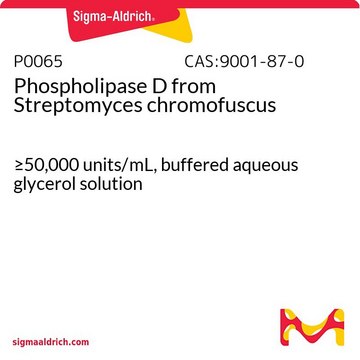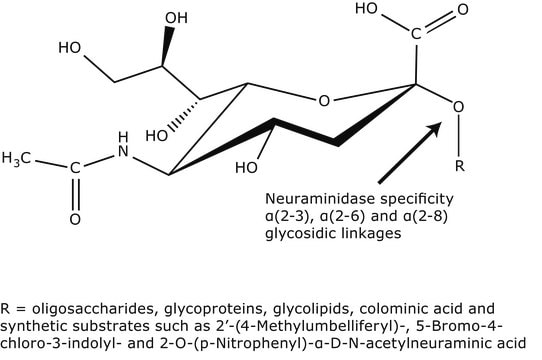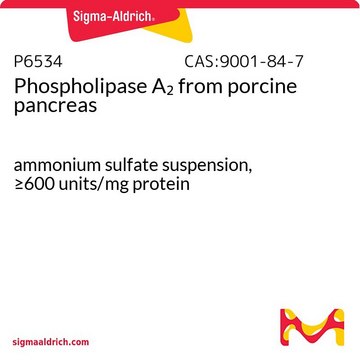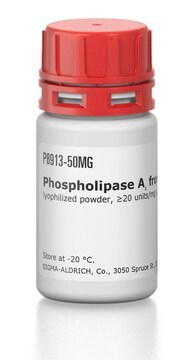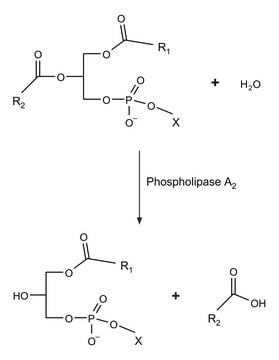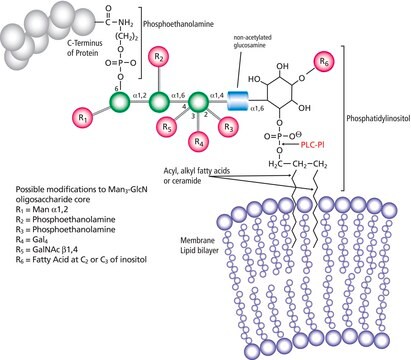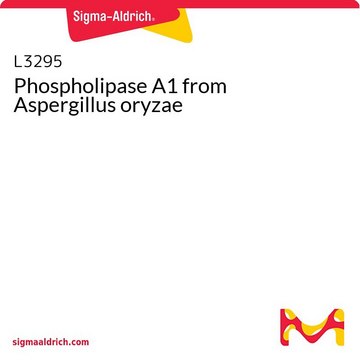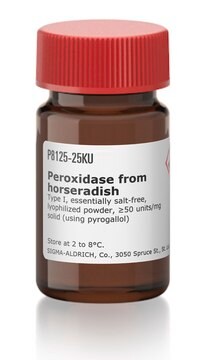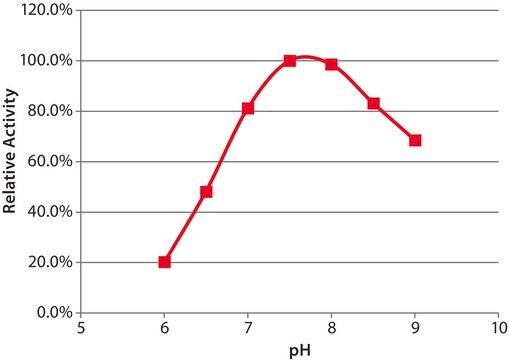P0515
Phospholipase D from Arachis hypogaea (peanut)
Type II, lyophilized powder, ≥60 units/mg protein
Sinônimo(s):
Lecithinase D, Phosphatidylcholine phosphatidohydrolase
Faça loginpara ver os preços organizacionais e de contrato
About This Item
Produtos recomendados
fonte biológica
Arachis hypogaea
Nível de qualidade
tipo
Type II
Formulário
lyophilized powder
atividade específica
≥60 units/mg protein
composição
Protein, ~30%
temperatura de armazenamento
−20°C
Procurando produtos similares? Visita Guia de comparação de produtos
Descrição geral
Phospholipase D is a phospholipid hydrolyzing enzyme and an important component of receptor-mediated signal transduction responses and regulated secretion.
Phospholipase D (PLD) is abundantly found in the eukaryotes and prokaryotes. It is present in all mammalian cells. In mammals, PLD is initiated by various hormones, neurotransmitters, growth factors and cytokines.
Aplicação
Phospholipase D from Arachis hypogaea (peanut) has been used in the preparation of lipase enzyme solution. It has also been used to determine its influence on human neutrophil respiratory function.
Research has shown ADP-ribosylation factor regulation of phospholipase D is important in the release of nascent secretory vesicles from the trans-Golgi network. It has also been used in a study to investigate stimulation of Na+-Ca2+ exchange activity in canine cardiac sarcolemmal vesicals.
Ações bioquímicas/fisiológicas
Hydrolyzes the phosphate bonds of phospholipids and sphingomyelin to give the corresponding phosphatidic acid.
Phospholipase D is involved in conferring drought susceptibility in peanuts, which increases the risk of aflatoxin contamination.
Phospholipase D (PLD) modulates cell growth, secretion and the actin cytoskeleton.
Definição da unidade
One unit will liberate 1.0 μmol of choline from L-α-phosphatidylcholine (egg yolk) per hr at pH 5.6 at 30 °C.
forma física
Partially purified, lyophilized powder containing buffer salts
Nota de análise
Protein determined using biuret, unless otherwise indicated.
Palavra indicadora
Danger
Frases de perigo
Declarações de precaução
Classificações de perigo
Resp. Sens. 1
Código de classe de armazenamento
11 - Combustible Solids
Classe de risco de água (WGK)
WGK 3
Equipamento de proteção individual
Eyeshields, Gloves, type N95 (US)
Escolha uma das versões mais recentes:
Já possui este produto?
Encontre a documentação dos produtos que você adquiriu recentemente na biblioteca de documentos.
Os clientes também visualizaram
B Z Guo et al.
Planta, 223(3), 512-520 (2005-10-04)
Preharvest aflatoxin contamination has been identified by the peanut industry as a serious issue in food safety and human health because of the carcinogenic toxicity. Drought stress is the most important environmental factor exacerbating Aspergillus infection and aflatoxin contamination in
K D Philipson et al.
The Journal of biological chemistry, 259(1), 16-19 (1984-01-10)
Treatment of canine cardiac sarcolemmal vesicles with phospholipase D resulted in a large stimulation (up to 400%) of Na+-Ca2+ exchange activity. The phospholipase D treatment decreased the apparent Km (Ca2+) for the initial rate of Nai+-dependent Ca2+ uptake from 18.2
Human neutrophil peptide receptors: mobilization mediated by phospholipase C.
Nelson R D, et al.
The American Journal of Pathology, 107(2), 202-202 (1982)
Expression and characterization of rat brain phospholipase D
Xie Z, et al.
Methods in Enzymology, 345, 255-264 (2002)
Giuseppe Dionisio et al.
Plant physiology, 156(3), 1087-1100 (2011-01-12)
Barley (Hordeum vulgare) and wheat (Triticum aestivum) possess significant phytase activity in the mature grains. Maize (Zea mays) and rice (Oryza sativa) possess little or virtually no preformed phytase activity in the mature grain and depend fully on de novo
Nossa equipe de cientistas tem experiência em todas as áreas de pesquisa, incluindo Life Sciences, ciência de materiais, síntese química, cromatografia, química analítica e muitas outras.
Entre em contato com a assistência técnica